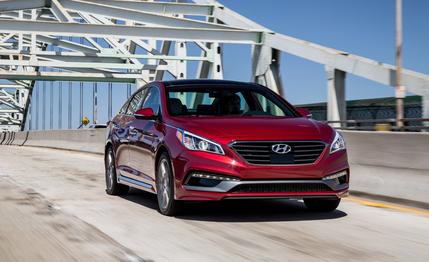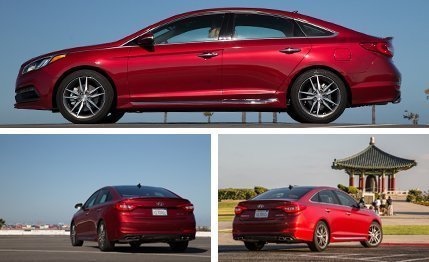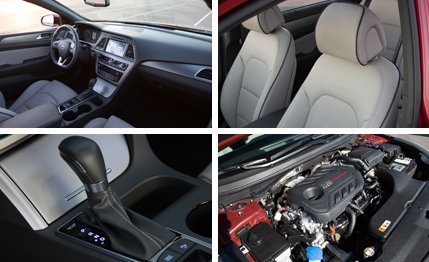
 Instrumented Test
Instrumented Test
Over its life span, the Hyundai Sonata has rarely made a powerful styling statement. (We’re not counting the powerfully ugly ones.) But the last Sonata stood as the looker in its set until it was eclipsed by its elegant Kia Optima stablemate and Ford’s new David Brown Fusion-Martin. For 2015, Hyundai has dialed back the radical in favor of an automobile built to blend.
In the interest of tractability (and fuel economy, no doubt), the engineers have gone light on power at the top of the line, equipping the top-spec 2.0-liter engine with a smaller turbocharger. As a result, horsepower drops to 245 from 274, and the new Sonata gives up a significant 1.9 seconds to our 2011 long-term 2.0T in the 0-to-60-mph sprint. The base car sallies forth with a naturally aspirated, 185-hp 2.4-liter four, while a turbocharged 1.6 arrives as the Eco-badged fuel-miser special. The 2.4 and the 2.0 turbo are paired with a six-speed autobox, but the 1.6 gets Hyundai’s seven-speed dual-clutch unit. The hybrid soldiers on with the old body style until 2016.
Back on the topic of styling, Hyundai seems to have lost some momentum here with the Sport version. The new design simply doesn’t hang together as well as did the previous hewn-from-soapstone model. The chrome on the sill extensions of our loaded Sport 2.0T looks unnecessary and slightly chintzy, while the rear spoiler seems as if somebody stuck it on as a test and then forgot to remove it. The lesser cars are more aesthetically successful.


In contrast, the interior is nicely thought out. There are no glaring ergonomic flaws, and the materials are at least average for this highly competitive class. Rear-seat occupants gain an inch of legroom over the outgoing car. The Sonata registers BMW 7-series quiet on the decibel meter, although the noises that get in aren’t the most pleasant. Wind roars around the A-pillars, and overt turbo whoosh pairs inharmoniously with some ’90s-hangover engine thrash. The visibility’s good and the seats are comfortable, and family folks and traveling salesmen won’t find driving the car fatiguing.
Our test car was a preproduction unit that Hyundai had driven out to California from its Montgomery, Alabama, plant, and it did suffer a significant mishap. An undertorqued hose clamp let go between the turbo and the intercooler. The resultant lack of boost at altitude in the Angeles National Forest left the car with what felt like a third of its rated horsepower.
We limped to a gas station for an ad-hoc repair with an undersize screwdriver, which held until our 30-to-50-mph test run at Hyundai’s high-desert proving ground. Facility techs torqued it back down and the car presented no further issues. But all of this could have resulted in compromised—read: slower—performance numbers, and we will be executing our battery of tests on another 2.0T as soon as possible.


We can’t say that the Sonata Sport shone as brightly as the Mazda 6 or Honda Accord on the mountain back roads prior to its loss of boost, but it’s every bit as rewarding to drive as a Fusion. Nor can we pan it as a disconnected machine. The grip-averse tires, which served up 0.80 g on the skidpad, still transmit enough warning to keep things from going hairball, while feedback through the wheel was present, welcome, and surprisingly vibrant. The Koreans have often been excoriated for engineering the numbest steering in the business, but the Sonata Sport 2.0T is another signal after the 2015 Genesis sedan that the trend may be reversing. The rack—unique among 2015 Sonatas—even betters those in some much more expensive iron from Europe.
The chassis improvements are striking, and braking suffers only one demerit: a pedal that’s a bit too eager to bite at first. The rest of the pedal’s travel is nice and linear, and our measured stopping distance is class-competitive at 178 feet from 70 mph.
Still, we question the company’s decision to call this model “Sport,” unless the sport to which they’re referring is curling. With that extra rear legroom and a trunk measuring 16.3 cubic feet, the Sonata will happily carry a burly four-man squad, a complement of stones, a set of brooms, and enough cold ones to keep the game heated.
So will it blend? Hyundai is betting that customers in the segment will like the smoothie it has served up. We like it just fine, despite the Sport model’s distinct absence of sportiness. Although we have a feeling its mixed bag of strengths and demerits would place it midpack in a class-wide comparison test, its finer qualities are ultimately those that win the day.